| Listing 1 - 10 of 150 | << page >> |
Sort by
|
Book
Year: 2003 Publisher: [Place of publication not identified] IEEE
Abstract | Keywords | Export | Availability | Bookmark
 Loading...
Loading...Choose an application
- Reference Manager
- EndNote
- RefWorks (Direct export to RefWorks)
Book
Year: 2003 Publisher: Piscataway, New Jersey : Institute of Electrical and Electronics Engineers,
Abstract | Keywords | Export | Availability | Bookmark
 Loading...
Loading...Choose an application
- Reference Manager
- EndNote
- RefWorks (Direct export to RefWorks)
Book
Year: 2003 Publisher: Piscataway, New Jersey : Institute of Electrical and Electronics Engineers,
Abstract | Keywords | Export | Availability | Bookmark
 Loading...
Loading...Choose an application
- Reference Manager
- EndNote
- RefWorks (Direct export to RefWorks)
Book
Year: 2003 Publisher: [Place of publication not identified] IEEE
Abstract | Keywords | Export | Availability | Bookmark
 Loading...
Loading...Choose an application
- Reference Manager
- EndNote
- RefWorks (Direct export to RefWorks)
Machine learning --- Cybernetics --- Engineering & Applied Sciences --- Computer Science
Book
ISBN: 0398084416 Year: 2003 Publisher: Springfield : Charles C Thomas,
Abstract | Keywords | Export | Availability | Bookmark
 Loading...
Loading...Choose an application
- Reference Manager
- EndNote
- RefWorks (Direct export to RefWorks)
This expanded second edition is an important reference volume on the theoretical foundations of art therapy. The text presents a detailed account of the origins and rationale of art therapy. The author underscores the need for a new model of intervention, describes the advantages of visual forms of cognition, discusses general system theory and the field of cybernetics, delineates several existing models of art therapy, and outlines the essential features of the psychocybernetic model-a model combining the verbal-analytic and the visual imagistic symbol systems. The text then focuses on implem
Art therapy. --- Cybernetics. --- Models, Psychological. --- Psychotherapy --- Rehabilitation --- Communication --- Sensory Art Therapies --- Models, Theoretical --- Therapeutics --- Behavioral Disciplines and Activities --- Investigative Techniques --- Complementary Therapies --- Information Science --- Psychology --- Models, Psychological --- Art Therapy --- Cybernetics
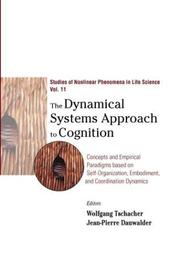
ISBN: 1281876798 9786611876791 981256439X 9812386106 9789812386106 9789812564399 Year: 2003 Publisher: River Edge, N.J. : World Scientific,
Abstract | Keywords | Export | Availability | Bookmark
 Loading...
Loading...Choose an application
- Reference Manager
- EndNote
- RefWorks (Direct export to RefWorks)
The shared platform of the articles collected in this volume is usedto advocate a dynamical systems approach to cognition. It is arguedthat recent developments in cognitive science towards an account ofembodiment, together with the general approach of complexity theoryand dynamics, have a major impact on behavioral and cognitivescience.
Cognition. --- Cognitive psychology. --- Self-organizing systems. --- Learning systems (Automatic control) --- Self-optimizing systems --- Cybernetics --- Intellect --- Learning ability --- Synergetics --- Psychology, Cognitive --- Cognitive science --- Psychology
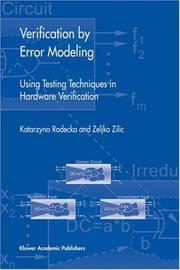
ISBN: 030648739X 1402076525 Year: 2003 Publisher: New York, NY : Springer US : Imprint: Springer,
Abstract | Keywords | Export | Availability | Bookmark
 Loading...
Loading...Choose an application
- Reference Manager
- EndNote
- RefWorks (Direct export to RefWorks)
1. DESIGN FLOW Integrated circuit (IC) complexity is steadily increasing. ICs incorporating hundreds of millions of transistors, mega-bit memories, complicated pipelined structures, etc., are now in high demand. For example, Intel Itanium II processor contains more than 200 million transistors, including a 3 MB third level cache. A billion transistor IC was said to be “imminently doable” by Intel fellow J. Crawford at Microprocessor Forum in October 2002 [40]. Obviously, designing such complex circuits poses real challenges to engineers. Certainly, no relief comes from the competitive marketplace, with increasing demands for a very narrow window of time (time-to-market) in engineering a ready product. Therefore, a systematic and well-structured approach to designing ICs is a must. Although there are no widely adhered standards for a design flow, most companies have their own established practices, which they follow closely for in-house design processes. In general, however, a typical product cycle includes few milestones. An idea for a new product starts usually from an - depth market analysis of customer needs. Once a window of opportunity is found, product requirements are carefully specified. Ideally, these parameters would not change during the design process. In practice, initial phases of preparing a design specification are susceptible to potential errors, as it is very difficult to grasp all the details in a complex design.
Engineering. --- Computers. --- Computer-aided engineering. --- Robotics. --- Automation. --- Electrical engineering. --- Electronic circuits. --- Robotics and Automation. --- Circuits and Systems. --- Electrical Engineering. --- Computer-Aided Engineering (CAD, CAE) and Design. --- Computing Methodologies. --- Electron-tube circuits --- Electric circuits --- Electron tubes --- Electronics --- Electric engineering --- Engineering --- Automatic factories --- Automatic production --- Computer control --- Engineering cybernetics --- Factories --- Industrial engineering --- Mechanization --- Assembly-line methods --- Automatic control --- Automatic machinery --- CAD/CAM systems --- Robotics --- Automation --- Machine theory --- CAE --- Automatic computers --- Automatic data processors --- Computer hardware --- Computing machines (Computers) --- Electronic brains --- Electronic calculating-machines --- Electronic computers --- Hardware, Computer --- Computer systems --- Cybernetics --- Calculators --- Cyberspace --- Construction --- Industrial arts --- Technology --- Data processing --- Control engineering. --- Artificial intelligence. --- Control, Robotics, Automation. --- Electronic Circuits and Systems. --- Electrical and Electronic Engineering. --- Artificial Intelligence.
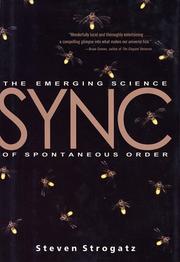
ISBN: 0786868449 Year: 2003 Publisher: New York Hyperion
Abstract | Keywords | Export | Availability | Bookmark
 Loading...
Loading...Choose an application
- Reference Manager
- EndNote
- RefWorks (Direct export to RefWorks)
Statistical physics --- Synchronization --- Self-organizing systems --- Synchronisation --- Systèmes auto-organisés --- Synchronization. --- Self-organizing systems. --- 124.1 --- #WSCH:AAS2 --- Learning systems (Automatic control) --- Self-optimizing systems --- Cybernetics --- Intellect --- Learning ability --- Synergetics --- Synchronism --- Time measurements --- Ordening. Chaos --- 124.1 Ordening. Chaos --- Systèmes auto-organisés
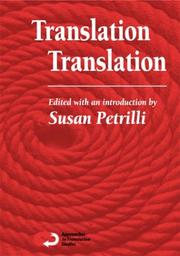
ISBN: 9042009470 9789042009479 9789004490093 9004490094 Year: 2003 Volume: 21 Publisher: Amsterdam Rodopi
Abstract | Keywords | Export | Availability | Bookmark
 Loading...
Loading...Choose an application
- Reference Manager
- EndNote
- RefWorks (Direct export to RefWorks)
In this theoretical framework essays have been included not only from major translation experts, but also from researchers working in different areas, in addition to semiotics and linguistics, also philosophy, literary criticism, cultural studies, gender studies, biology, and the medical sciences. All scholars work on problems of translation in the light of their own special competencies and interests. Translation Translation contributes to current debate on the question of translation dealt with in an interdisciplinary perspective, with implications not only of a theoretical order but also of the didactic and the practical orders. In the context of globalization the question of translation is fundamental for education and responds to new community needs with reference to Europe and more extensively to the international world. In its most obvious sense translation concerns verbal texts and their relations among different languages. However, to remain within the sphere of verbal signs, languages consist of a plurality of different languages that also relate to each other through translation processes. Moreover, translation occurs between verbal languages and nonverbal languages and among nonverbal languages without necessarily involving verbal languages. Thus far the allusion is to translation processes within the sphere of anthroposemiosis. But translation occurs among signs and the signs implicated are those of the semiosic sphere in its totality, which are not exclusively signs of the linguistic-verbal order. Beyond anthroposemiosis, translation is a fact of life and invests the entire biosphere or biosemiosphere, as clearly evidenced by research in "biosemiotics", for where there is life there are signs, and where there are signs or semiosic processes there is translation, indeed semiosic processes are translation processes. According to this approach reflection on translation obviously cannot be restricted to the domain of linguistics but must necessarily involve semiotics, the general science or theory of signs.
Theory of literary translation --- Literary semiotics --- Translation science --- Sociolinguistics --- Translating and interpreting --- Semiotics --- #KVHA:Vertaalwetenschap --- #KVHA:Vertaaltheorie --- Peirce, Charles S. --- Semiotiek --- Vertaalwetenschap --- Vertalen en filosofie --- Vertalen en semiotiek --- Semiotiek. --- Vertaalwetenschap. --- Vertalen en filosofie. --- Vertalen en semiotiek. --- Biosemiotics --- Character --- Cybernetics --- Text theory --- Semeiotics --- Semiology (Linguistics) --- Semantics --- Signs and symbols --- Structuralism (Literary analysis) --- Mechanical brains --- Control theory --- Electronics --- System theory --- Ethology --- Ethics --- Personality --- Sémiotique --- Traduction
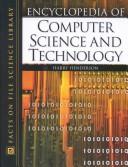
ISBN: 0816043736 Year: 2003 Publisher: New York (N.Y.): Facts on File
Abstract | Keywords | Export | Availability | Bookmark
 Loading...
Loading...Choose an application
- Reference Manager
- EndNote
- RefWorks (Direct export to RefWorks)
Computer science --- Computers --- Informatique --- Ordinateurs --- Encyclopedias --- Encyclopédies --- 681.3 --- Computerwetenschap --- Encyclopédies --- Automatic computers --- Automatic data processors --- Computer hardware --- Computing machines (Computers) --- Electronic brains --- Electronic calculating-machines --- Electronic computers --- Hardware, Computer --- Computer systems --- Cybernetics --- Machine theory --- Calculators --- Cyberspace --- Informatics --- Science --- 681.3* / / / / / / / / / / / / / / / / / / / / / / / / / / / / --- Encyclopedias.
| Listing 1 - 10 of 150 | << page >> |
Sort by
|

 Search
Search Feedback
Feedback About UniCat
About UniCat  Help
Help News
News